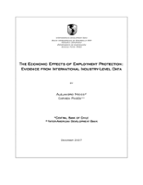The Economic Effects of Employment Protection: Evidence from International Industry-Level Data
Date
Dec 2007
This paper examines the economic effects of employment protection legislation in a sample of developed and developing countries. Implementing a difference-in-differences test lessens the potentially severe endogeneity and omitted variable problems associated with cross-country regressions. This test is based on the hypothesis that employment protection regulations are more binding in sectors of activity exposed to higher volatility in demand or supply shocks. The analysis indicates that more stringent legislation slows down job turnover by a significant amount, and that this effect is more pronounced in sectors that are intrinsically more volatile. The paper also finds that employment and value added decline in the most affected sectors, and employment and output effects are driven by a decline in the net entry of firms. In contrast, average employment per plant is not significantly affected.



